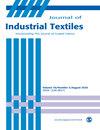Particle type composite phase change materials via microemulsion impregnation for photothermal conversion and temperature regulation of surface coatings
IF 2
4区 工程技术
Q1 MATERIALS SCIENCE, TEXTILES
引用次数: 0
Abstract
In order to facilitate the combination of composite phase change materials (CPCMs) and fabrics, granular CPCMs were prepared, a simple vacuum impregnation method was used to adsorb n-octadecane with disc-shaped diatomite as a carrier. To improve the adsorption capacity of n-octadecane on diatomite, the average pore size of its single point was increased from 13.35 nm to 25.54 nm through acidification. The microemulsion of n-octadecane liquid with particle size of less than 200 nm was immersed into the diatomite under vacuum conditions, and after demulsification, the particle type CPCMs with a particle size of about 30 μm was prepared. The stability, thermal properties of particle type CPCM, and its thermoregulation on textile were systematically studied. The particle type CPCM with the latent heat energy of 34.69 J/g revealed no phase leakage when heated for 30 min at 50°C. The impregnation rate of acidified diatomite was increased by 51.7% compared with original diatomite. The CPCMs mixed with polyurethane was coated on the surface of cotton fabric and evaluated the thermal properties of the fabric. The fabric was allowed to absorb heat at 40°C to reach saturation. Analysis showed that the heat storage performance of the fabric was increased by 7.9%, and the temperature difference was adjusted to 2.9–3.1°C, which effectively slowed down thermoregulatory in a relatively low temperature environment. Moreover, the coated particle type CPCM did not alter the coldness of the cotton fabric.颗粒型复合相变材料通过微乳液浸渍进行光热转化和表面涂层温度调节
为了促进复合相变材料(CPCMs)与织物的结合,采用简单的真空浸渍法,以圆盘状硅藻土为载体,制备了颗粒状CPCMs,吸附正十八烷。为了提高正十八烷在硅藻土上的吸附能力,通过酸化将其单点平均孔径从13.35nm增加到25.54nm。在真空条件下,将粒径小于200nm的正十八烷液体微乳液浸入硅藻土中,经破乳后,制备出粒径约为30μm的颗粒型CPCMs。系统地研究了颗粒型CPCM的稳定性、热性能及其对纺织品的热调节性能。潜热能为34.69J/g的颗粒型CPCM在50°C下加热30分钟时没有显示出相泄漏。酸化硅藻土的浸渍率比原硅藻土提高了51.7%。将CPCMs与聚氨酯混合涂布在棉织物表面,并对织物的热性能进行了评价。让织物在40°C时吸收热量以达到饱和。分析表明,织物的储热性能提高了7.9%,温差调节到2.9–3.1°C,在相对较低的温度环境下有效减缓了温度调节。此外,涂层颗粒型CPCM不会改变棉织物的冷度。
本文章由计算机程序翻译,如有差异,请以英文原文为准。
求助全文
约1分钟内获得全文
求助全文
来源期刊

Journal of Industrial Textiles
MATERIALS SCIENCE, TEXTILES-
CiteScore
5.30
自引率
18.80%
发文量
165
审稿时长
2.3 months
期刊介绍:
The Journal of Industrial Textiles is the only peer reviewed journal devoted exclusively to technology, processing, methodology, modelling and applications in technical textiles, nonwovens, coated and laminated fabrics, textile composites and nanofibers.
 求助内容:
求助内容: 应助结果提醒方式:
应助结果提醒方式:


